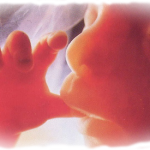Summary of Church Teaching on Marriage
Catholics see marriage in its highest form as a sacrament instituted by Our Lord Jesus Christ, that is a sign of, and a participation in Christ’s love for His Bride, the Church. The Church has always defined marriage as a life-long, male-female relationship, open to bringing new life into the world. That is her Faith. In forming the covenantal bond, the man and woman become “one flesh” (Gen. 2:24) and this is also a sign of the Trinity itself – a union of two persons forming a new person through the covenanted love of husband and wife. Marriage is sacred. In the Old Testament, the prophets use it to describe God’s relationship with his people of Israel: “I will betroth you to me forever; I will betroth you in righteousness and justice, in love and compassion. I will betroth you in faithfulness, and you will acknowledge the Lord” (Hos. 2:10). In the Gospel of John, Jesus is compared to a bridegroom, and in Revelation we read that “the wedding of the Lamb has come, and his bride has made herself ready” (Rev.19:7-9). Christian marriage excludes same-sex marriage; polygamy (where a man or woman has more than one spouse); and polyandry (where a woman has more than one husband). Any attempt to redefine marriage is an attack on the family unit which is the bastion of life.
Rights pertain to what is fitting to
human nature
human nature
Human reproductive powers are ordered to producing new humans. Rightly ordered, then, human sexuality must respect this end. The homosexually-inclined ignore this ordination in favour of the secondary and complementary end, sexual pleasure. No one has a right to ignore the ordinations of the nature s/he has been given.
The battle is not about equal rights but about the
security and future of society.
security and future of society.
Importantly, children have a human right that is inalienable to two parents – mother and father. Moreover, though children have a right to parents, we do not have the right to children. They cannot be owned!
Before the state can exist there must be society; before society can exist there must be stable families; before stable families can exist there must be marriage, the permanent union of a man and a woman for the sake of their children and their own sake. Marriage makes families, and families are the fabric of society.
Marriage cannot be messed with.
It is what it is, or it is nothing.
It is what it is, or it is nothing.
Arguments put forward to recognise same-sex unions as ‘marriage’
We need to make a few distinctions. First, law is an ordinance of reason for the common good of society and its members. Particular laws may need to be altered to deal with a change in conditions but no new law, if it is truly a law (for the good of society and its members) can ignore that good. Otherwise, it turns into a species of violence forcing society’s members to embrace what is harmful. The invention of the roundabout assisting movement of motor traffic, required a law giving a right of way to a car which had entered the roundabout over the right of other drivers. A law which, for instance, gave right of way to the fastest car to enter a roundabout, would inevitably bring harm to other road users and would be a bad law. But there is another and even more important distinction. The essence of marriage—i.e., what marriage is—is not something determined by human law. It is prior both in time and in reality to any human law. Long before any state or government ever existed, before written laws were produced, men and women married. They did so as a consequence of their nature. Posited laws (statutes, regulations) may determine the conditions to be met for a marriage to be lawful and valid. They may provide for its celebration and its recording. But such laws simply put legal flesh on a natural institution. In 1534, King Henry VIII prevailed on his parliament to pass a law ‘legalising’ his own unilateral act of putting aside his marriage to his Queen, Catherine of Aragon, and another law compelling his subjects to recognise this unilateral action. In doing this, he sought to make subject to human will what was prior to human will. His action succeeded in disturbing the foundations of marriage through the brutal enforcement of these ‘laws’ by his henchman, Thomas Cromwell, and because of the subsequent success of the revolt against the guardian of the moral law, the Catholic Church, in the British Isles. The precedent of making marriage subject to the will of man as to its permanence led inevitably to the view that marriage is subject to man’s will as to its essence. It is this view which is at the heart of the push to allow those of the same sex to marry.
The law that determines marriage’s essence is a law of nature not of human making. Just as a man is not free to change his own essence (what he is), neither is he free to change the essence of marriage. To complete the argument, man is determined by nature both as to what he is and how he operates. If he attempts to break that mould, to force nature to meet his demands, he will inevitably come to grief.
The Roman poet Horace put the issue well :
Naturam expelles furca, tamen usque recurret — “You may drive nature out with a pitchfork, she will always return.”
Human rights cannot, by definition, extend to a right to ignore the natural order.
Hence, it does not follow that because nature allows a man and a woman to marry, homosexuals should be allowed to solemnise their unnatural ‘union’ in analogous fashion. Homosexual couples may formalise some sort of union between them but such a union is not marriage because it breaches the definition of marriage (the conjugal union of a man and a woman for the procreation of children). It is impossible, moreover, that such a union could produce offspring naturally (per se), only through artifice or adoption (per accidens). Nor is it possible for the union to result in the good per se of the two, even if there should result some good per accidens.
First, let’s ask ourselves what being ‘better off’ really means? The language is rhetorical and without foundation unless one inserts some additional terms: such as better off than heterosexuals. Is one better off to receive a speeding a fine for $180 instead of one for $360? Most would say, yes. The common sense answer is not to compare one figure with another but rather strive to not be booked at all. The aphorism attributed to Mao Tse Tung is to the point: Use my words and you will think my thoughts. It reflects the philosophical truism that words are signs of concepts. If I want you to accept my concepts I must persuade you to use the word I have assigned to it. Homosexual is derived from the Greek word homós meaning ‘the same’. “Gay”, whether used as an adjective or noun, is a euphemism designed to present those with homosexual inclinations as living a joyous, and desirable, lifestyle. Homosexuals invented another term to indicate a hatred of homosexuality or homosexuals by ignoring the proper use of the Greek sourced prefix in the word ‘homo-phobia’. Having invented it, they began to use the word as a term of obloquy to condemn those opposed to the ideology. So, be wary of falling for slogans that sound good but are going nowhere.
In what manner is one ‘more secure’ in a relationship that is a parody of marriage? Partners in business, who hopefully are not partners in crime, seek legal advice from solicitors to ensure that their contractual arrangements are mutually agreeable and that each individual attains the supposed security of personal assets, finance and whatever else is being sought in their contracts. Generally security is assured by another outside of the relationship, as is the case of business partners. So the question needs to be pondered: “Who is that third party that will provide the supposed ‘security’ in this relationship? Moreover, the various entitlements and necessary material security can be achieved without the change to the institution of marriage.
There is no such thing as a LGBTQ child. Children are the offspring of heterosexual married couples. They are the fruit of married love and as such are a ‘gift’, not a commodity or object that can or should be sought by extraneous means. So, one does not a have a right to a child. No-one has a ‘right’ to a child because children are subjects and one cannot own a subject as is the case with objects which are things. One need not look far to find clear evidence that children need both the influence of a maternal and paternal parent in their life. Apart from having that as a natural right, there exists a deluge of psychological data to support the natural gender balance to provide a formative development of the psychosomatic personality of the child. In sole parent families this is often found outside of the home in familial relationships or sport or extra-curricular activities to provide that role gender-identification formation lacking in such homes.
How can redefining a word enrich it? How can the destruction of something be construed with its construction? Once the word is redefined in any manner whatsoever then it has lost all of its meaning – it becomes meaningless. Words cannot be redefined and remain what they are. Words convey meaning and meanings are real. Change the words and you change reality. Marriage does not need a subjective gloss to improve it.
Famous Quotes
“Marriage is like fine wine; it improves with age and appreciates in value. Torrents of worries and difficulties are incapable of drowning true love because people who sacrifice themselves generously are brought closer together in the long run.” ~ St Josemaria Escrivá
Kevin Andrews MP in his book, Maybe I Do notes, “The tragedy of the retreat from marriage is not the billions of dollars it costs each year: it is the personal and emotional trauma which research increasingly indicates affects many children, even into their adulthood; and the consequent diminution of health, educational opportunities, and well-being, including the stability of relationships of children whose parents divorced.”
Basis of Debate
The debate on same-sex ‘marriage’ is a hotbed of confusion and the media is doing very little to represent both sides equally and sincerely. It is not a personal issue for most Australians but is paraded as such, by a vibrant minority that have infiltrated the media. It is also largely misunderstood as an emotional union. Sincere arguments made by Christians are ipso facto inadmissible in our secularised political environment. Same-sex ‘marriage’ is portrayed as a ‘rights’ issue: “No one should suffer for the colour of his skin; no one should suffer over his sexual predilections.” But this secular ‘take’ on the topic blurs distinctions. Few seem to understand that the very stability of society is at stake.
Quick Facts
Love has many facets: philia is true disinterested love for mankind. That is, love of friendship (e.g. an abortion sidewalk counsellor who is detached from emotion and the circumstance of a girl/woman contemplating abortion, demonstrates philia love for her because abortion is wrong and will leave her wounded and her child dead. Agape means brotherly love as in a family or church. As Pope Emeritus Benedict notes, agape expresses the experience of a love which involves a real discovery of the other, moving beyond the selfish character that prevailed earlier. Love now becomes concern and care for the other. No longer is it self-seeking, sinking in the intoxication of happiness; instead it seeks the good of the beloved: it becomes renunciation and it is ready, and even willing, for sacrifice. Eros implies the sentiments and emotions that lead on to sexual love. Eros, reduced to pure sex, has become a commodity, a mere thing to be bought and sold, or rather, man himself becomes a commodity. In order to exist, eros is dependent upon the situation and circumstances. As long as a couple is enjoying a romantic situation, eros can thrive. But, as soon as hurtful words or actions appear, eros simply evaporates. Eros is also held captive to each person’s perception. Therefore, eros cannot provide a reliable basis for building a deep and meaningful relationship since it is so fickle and dependent upon perception and circumstances.
- Martin Luther relegated the status of marriage to a secular adjudication, thereby removing it from the Church as a sacrament.
- Henry VIII was conferred by the pope, with the title of ‘Defender of the Faith’ for writing Defense of the Seven Sacraments in response to Martin Luther’s heresies. However, in time, this defender of the faith launched an assault on the Catholic Church in order to obtain a divorce from Catherine of Aragon and to marry Anne Boleyn because he wanted a son to succeed him. Henry VIII seceded from Rome in 1534 under the Act of Succession, making himself the head of the Church of England and the state. As it turns out, Anne Boleyn was not able to provide a male heir and Henry VIII murdered her.
- Until 1930, all Protestant denominations agreed with the Catholic Church’s teaching condemning contraception as sinful. At its 1930 Lambeth Conference, the Anglican church, swayed by growing social pressure, announced that contraception would be allowed in some circumstances. Soon the Anglican church completely caved in, allowing contraception across the board. Since then, all other Protestant denominations have followed suit.
- The widespread availability of contraception and the sexual revolution that started in the 1960s, led to increased adultery, divorce, sexually transmitted infections, and abortions which continue to pervade Western culture. Is it any wonder then that proponents of same-sex ‘marriage’ demand that marriage be extended to them as well? As this short historical account highlights, marriage has been compromised and diminished. Many Christians have participated in the compromise by their inaction to defend and uphold marriage. The relative ease to accept alternate views has placed same-sex ‘marriage’ in Parliament. The state may lay down the terms surrounding its celebration and its recording, but marriage does not get its validity from the state. Men and women were marrying long before any state, government or parliament ever existed.
In 2017 Australians voted to change the definition of marriage via a postal survey. As a result the Marriage Act 1961 was updated on 9 December 2017 to define marriage as “the union of 2 people to the exclusion of all others, voluntarily entered into for life”.
There are a growing number of incidents where Christian cake bakers, photographers, and florists are being sued for sexual orientation discrimination because they are refusing to provide their services to LGBTQ couples wishing to celebrate their same-sex ceremony.
Countless studies show that both genders make important gender-related contributions to marriage and family life. For decades, the social sciences have provided clear and convincing evidence that not all family structures are the same with respect to facilitating healthy family environments. Refer to Scholar Studies references below.
Suggested articles for further reading and links
- Video/Audio Fr. Peter Murphy presentation Marriage & Morality and/or Mr. Eamonn Keane presentation Marriage in God’s Plan – the Pivot of Civilisation from 2012 Albury conference available on CD. To order, Contact Us
- Reading/Links
- Pope Pius XI, Encyclical on Marriage: Casti connubii, 1930.
- Second Vatican Council, Gaudium et spes, 1965, nn.
-
Congregation Doctrine of the Faith, Declaration on Certain Questions Concerning Sexual Ethics – Persona Humanae, 1975.
-
Council of the Family, Truth and Meaning of Human Sexuality, 1995.
-
Council of the Family, Family, Marriage, and De Facto Unions, 2000 (n. 23)
-
Kevin Andrews, Maybe I Do: Modern Marriage & the Pursuit of Happiness. Victoria: Connor Court Publishing Pty Ltd, 2012. See Book review
- Dr. Jennifer Roback-Morse, 77 Non-Religious Reasons to Support Man/Woman Marriage, The Ruth Institute. Accessed 19 December 2013 View PDF
- Sherif Girgis et al, What is Marriage? Man and Woman: A Defense. New York: Encounter Books, 2012.
Scholar Studies
- Mark Regnerus, How different are the adult children of parents who have same-sex relationships? Findings from the New Family Structures Study, Social Science Research 41(4) (Jul 2012). Purchase here
- Dean Byrd, Gender Complementarity and Child-Rearing: Where Tradition and Science Agree, 6 J. L. & Fam. Stud. 213 (2004)
- Douglas W. Allen, High school graduation rates among children of same-sex households, Rev. Econ. Household, Sept. 2013
- Douglas W. Allen, Catherine Pakaluk & Joseph P. Price, Nontraditional Families and Childhood Progress Through School: A Comment on Rosenfeld, Demography, November 2012 View here
- Paul R. Amato, More Than Money? Men’s Contributions to Their Children’s Lives?, in Men in Families, When Do They Get Involved? What Difference Does It Make? 267 (1998)
- Paul R. Amato & Fernando Rivera, Paternal Involvement and Children’s Behavior Problems, 61 Journal of Marriage and the Family 375 (1999)
- Gunnar Anderson, et al., The Demographics of Same-Sex Marriages In Norway and Sweden, 43 Demography 79 (2006)
- Marilyn Coleman, et al., Reinvestigating Remarriage: Another Decade of Progress, 62 Journal of Marriage and the Family 1288 (2000)
- Scott Coltrane, Family Man 54 (1996)
- Suzanne A. Denham, et al., Prediction of Externalizing Behavior Problems From Early to Middle Childhood: The Role of Parental Socialization and Emotion Expression, in Development and Psychopathology 23 (2000)
- M. DeWolff & M. van Izjendoorn, Sensitivity and Attachment: A Meta-Analysis on Parental Antecedents of Infant Attachment, 68 Child Development 571 (1997)
- Greg Duncan & Jeanne Brooks-Gunn, Consequences of Growing Up Poor (1999)
- Ruth Feldman, Oxytocin and Social Affiliation In Humans, 61 Hormones and Behavior 380 (2012)
- Mark V. Flinn, et al., Fluctuating Asymmetry of Stepchildren, 20 Evolution of Human Behavior 465 (1999)
- Norval D. Glenn, The Struggle for Same-Sex Marriage, 41 Society 25 (2004)
- Colleen Hoff & Sean Beougher, Sexual Agreements Among Gay Male Couples, 39 Archives of Sexual Behavior 774 (2010)
- Sandra L. Hofferth, et al., The Demography of Fathers: What Fathers Do, in Handbook of Father Involvement: Multidisciplinary Perspectives 81 (2002)
- Michael E. Lamb, Fathers: Forgotten Contributors to Child Development, 18 Human Development 245 (1975)
- Robert Lerner & Althea K. Nagai, No Basis: What the Studies Don’t Tell Us About Same-Sex Parenting (Marriage Law Project, 2001)
- Laura Lott-Whitehead and Carol T. Tully, The Family Lives of Lesbian Mothers, 63 Smith College Studies in Social Work 275 (1993)
- Eleanor Maccoby, The Two Sexes 266 (1998)
- M. Main & J. Solomon, Discovery of an Insecure-Disorganized/Disoriented Attachment Pattern, in Affective Development in Infancy 95 (1986)
- Wendy D. Manning & Kathleen A. Lamb, Adolescent Well-Being in Cohabiting, Married, & Single-Parent Families, 65 Journal of Marriage and the Family 876 (2003)
- Loren D. Marks, Same-Sex Parenting and Children’s Outcomes: A Closer Examination of the American Psychological Association’s Brief on Lesbian and Gay Parenting, 41 Social Science Research 735 (2012)
- Sara McLanahan & Gary Sandefur, Growing Up With a Single Parent: What Hurts, What Helps 1 (1994)
- Brent Miller, et al., Comparisons of Adopted and Non-Adopted Adolescents In a Large,Nationally Representative Sample, 71 Child Development 1458 (2000)
- Kristen Anderson Moore, et al., Marriage from a Child’s Perspective, Child Trends Research Brief (2002)
- C.A. Nelson and M. Bosquet, Neurobiology of Fetal and Infant Development:Implications for Infant Mental Health, in Handbook of Infant Mental Health 37, (2d ed. 2000)







